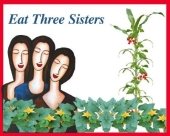





 5
5








 2
2




"You must be the change you want to see in the world." "First they ignore you, then they laugh at you, then they fight you, then you win." --Mahatma Gandhi
"Preach the Gospel always, and if necessary, use words." --Francis of Assisi.
"Family farms work when the whole family works the farm." -- Adam Klaus




 Permaculture workshop slides 2014 jpg.031 by Salamander Springs Farm: Susana's Perma-organics, on Flickr
Permaculture workshop slides 2014 jpg.031 by Salamander Springs Farm: Susana's Perma-organics, on Flickr
 2
2




Owner, Etta Place Cider




Ann Torrence wrote:Beans that don't shatter (spontaneously open) is the key to harvesting this mess. I'm trying a bunch of new-to-me beans from Native Seeds/SEARCH, like this Taos red pole bean.
4" sounds about right. One great thing about that Painted Mountain corn is it can go into 50 degree soil. That gains me a couple weeks on the whole operation.
And Joseph is spot on - I do this in a space about 10x20. If I had to grow for subsistence or market, I would modify it for ease of cultivation, etc. From what I recall about the southwest natives who used similar growing techniques, these fields were planted before the monsoons of mid-summer, but then they went on their seasonal migration to higher altitudes, so the fields didn't get much tending until they cycled back in the fall for harvest.











Brandon Greer wrote:Do you know if rattlesnake beans shatter?
Owner, Etta Place Cider
 2
2




 3
3




 11
11








Alder Burns wrote:I have had success with three sisters gardens, and derivations on them, in Georgia for years. The main point to bear in mind is that the goal was durable, storable produce for winter use and beyond....in other words dry corn, dry beans, and hard-shelled winter squash. Yes, it grows up into an impenetrable jungle....that's the point.....the space is fully occupied, "stacked and packed", giving weeds minimal opportunity to get a foothold. You go in and harvest everything at once after first frost kills all the green growth down. The corn must be planted first, and I would say it should be a foot or two tall, before adding the others....but this is in the South with plenty of growing season....perhaps it needs to be closer together in time further north. The danger is the bean vines, or even the squash, overwhelming the corn before it gets a chance to grow up. Even later on, vigorous bean vines can break down the corn. So you need good old heirlooms with stout tall stalks....things like "Hickory King" or "Sweet Bay". Wimpy 5 foot sweet corns or short hybrid popcorns and such like won't do. Layout helps too. Don't plant the corn in rows. Plant it in "hills"....that is, groups of 3-4 stalks together, then leave 3-4 feet of space either way to the next hill. The bean vines tangle the stalks together and make a strong support. If your beans look extra vigorous and likely to break the corn down, tying the cornstalks together near the top, sort of like a tipi, adds extra strength.
When you have it down, it's a fun design to play with, changing spacing, planting times, and adding or substituting other things.... Largely it's a matter of architecture, and similar plants can be added or exchanged as desired. Sunflowers, especially the tall ones, might have been used traditonally, and fit in very well, making a stronger support for beans than corn does. Vining cowpeas do as well, or even better (especially far South) than ordinary dry pole beans....they seem more tolerant of rain and humidity as they are maturing. The ground cover can be just about any cucurbit, although most of the others (melons, etc.) need to be harvested fresh which means thrashing in there to pick them. So plant them along the edges of the patch. Sweet potatoes are another possibility....... The Central American version of this idea is called milpa, and just about everything went into it....tomatoes, peppers, and such, and tropical perennials like banana and papaya and sugar cane, which eventually filled up the space while the annuals went on to a new plot......
 3
3




 2
2




 1
1








Experiment, invent, build, grow, share....lead by example people!!!
 1
1




Brandon Greer wrote:
2. Can anyone recommend a pinto pole bean that will go well with the Cherokee white flour corn?
Mandrake...takes on and holds the influence
of the devil more than other herbs because of its similarity
to a human. Whence, also, a person’s desires, whether good
or evil, are stirred up through it...
-Hildegard of Bingen, Physica
 2
2




Joseph Lofthouse wrote:
Has any descendent of colonists successfully planted a 3 sisters garden?
 6
6






Cultivate abundance for people, plants and wildlife - Growing with Nature



 6
6





|
What are you doing in my house? Get 'em tiny ad!
The new permaculture playing cards kickstarter is now live!
https://www.kickstarter.com/projects/paulwheaton/garden-cards
|








